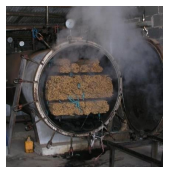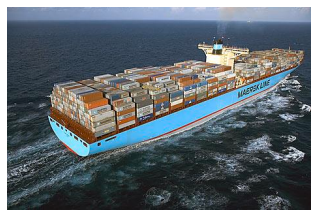Why we don't sell bamboo flooring
 We are often asked if we carry bamboo flooring. Of course, we do not. A lot of people have the misconception that bamboo flooring is the most environmentally friendly flooring option when in fact, it is actually the opposite. The majority of marketing for bamboo flooring is based solely around this fallacy, but is very convincing to the average consumer who wants to go “green.”
We are often asked if we carry bamboo flooring. Of course, we do not. A lot of people have the misconception that bamboo flooring is the most environmentally friendly flooring option when in fact, it is actually the opposite. The majority of marketing for bamboo flooring is based solely around this fallacy, but is very convincing to the average consumer who wants to go “green.”
Here is a walk through comparison of the three main manufacturing steps of both bamboo and Canadian made hardwood flooring. It will help you decide for yourself which option is better for the environment.
The Manufacturing Process of Bamboo Flooring
The first step in the process is the harvesting of the raw material and this in essence is where bamboo earns its reputation as the “green” alternative to solid wood. Bamboo can grow up to 2 feet in a single day. Compare this to hardwood trees which take between 40 and 60 years to fully mature. In this case bamboo does seem to be the “greenest” option. Although it takes hardwood trees far longer to mature, the growth in our forests is far greater than the removals. The trees that are sprouting today will not be needed for over 100 years. Contrary to popular belief, hardwood forests in North America are harvested very sustainably. The “clear cutting” you see on the news is done in softwood forests like pine and spruce. The mature trees in the forests are marked with spray paint by either the logger themselves or someone from the ministry of natural resources and these are the only trees to be cut down. This practice provides light for the smaller trees so they can one day reach their maturity. Standing hardwood volume in North America is currently 328 billion cubic feet, which is an increase of 90% since 1953. One of our lumber suppliers, Chisholm lumber owns thousands of acres and have been harvesting that same land since 1857.
and 60 years to fully mature. In this case bamboo does seem to be the “greenest” option. Although it takes hardwood trees far longer to mature, the growth in our forests is far greater than the removals. The trees that are sprouting today will not be needed for over 100 years. Contrary to popular belief, hardwood forests in North America are harvested very sustainably. The “clear cutting” you see on the news is done in softwood forests like pine and spruce. The mature trees in the forests are marked with spray paint by either the logger themselves or someone from the ministry of natural resources and these are the only trees to be cut down. This practice provides light for the smaller trees so they can one day reach their maturity. Standing hardwood volume in North America is currently 328 billion cubic feet, which is an increase of 90% since 1953. One of our lumber suppliers, Chisholm lumber owns thousands of acres and have been harvesting that same land since 1857.
The second step is the actual manufacturing process. Bamboo must be cut into lengths, ripped into thin strips, laminated together with formaldehyde based glue, milled into a tongue and groove, and then finished. All of this is done with no regulations on the plant, glue, finish, or waste. Not to mention, 80% of the electricity for these plants is generated from coal. This process is pretty complex when compared with the manufacturing process of hardwood flooring. The logs are sawn into lumber, the lumber is milled into flooring, and then a 0% Voc finish is applied. Flooring takes less water and energy to produce than any other flooring option. The only by product is sawdust which can be used as bedding for horses or made into wood pellets. Waste from the manufacturing of bamboo flooring can be very toxic and is sent to landfills or dumped illegally.
The Impacts of Shipping on the Environment and Bamboo Flooring
 Finally, we come to the last step in the process, shipping. For most products, the biggest impact on the environment is from shipping. The environmental impact of shipping Canadian made hardwood flooring in Canada is very minimal, but the impact of bamboo is huge. Bamboo is shipped across the ocean in huge container ships. These ships use a regular grade diesel when near ports or other regulated waters, but when they are in international waters they burn a far lower grade of diesel that is cheaper and causes far more pollution. According to the UK newspaper The Guardian and other sources; 15 of the world’s largest container ships pollute more than all of the automobiles in the world. To put this in a more local perspective, one container ship coming from Shanghai to Montreal will pollute more than all of the registered automobiles in Canada driving 70,000 kilometers.
Finally, we come to the last step in the process, shipping. For most products, the biggest impact on the environment is from shipping. The environmental impact of shipping Canadian made hardwood flooring in Canada is very minimal, but the impact of bamboo is huge. Bamboo is shipped across the ocean in huge container ships. These ships use a regular grade diesel when near ports or other regulated waters, but when they are in international waters they burn a far lower grade of diesel that is cheaper and causes far more pollution. According to the UK newspaper The Guardian and other sources; 15 of the world’s largest container ships pollute more than all of the automobiles in the world. To put this in a more local perspective, one container ship coming from Shanghai to Montreal will pollute more than all of the registered automobiles in Canada driving 70,000 kilometers.
 To truly recognize how “green” a product is, you must take the entire life cycle of that product into consideration. Bamboo flooring is fairly new to the market and hasn’t proven itself to be a good long term option. It is quite possible in a few years it will be taking up space in our landfills like carpet, vinyl, and laminate flooring are. In European castles like Versailles, you will see hardwood floors that have been installed for hundreds of years. Hardwood flooring should never end up in a landfill, and at the very least if you decide to tear up your flooring, it can be burned as fuel.
To truly recognize how “green” a product is, you must take the entire life cycle of that product into consideration. Bamboo flooring is fairly new to the market and hasn’t proven itself to be a good long term option. It is quite possible in a few years it will be taking up space in our landfills like carpet, vinyl, and laminate flooring are. In European castles like Versailles, you will see hardwood floors that have been installed for hundreds of years. Hardwood flooring should never end up in a landfill, and at the very least if you decide to tear up your flooring, it can be burned as fuel.
